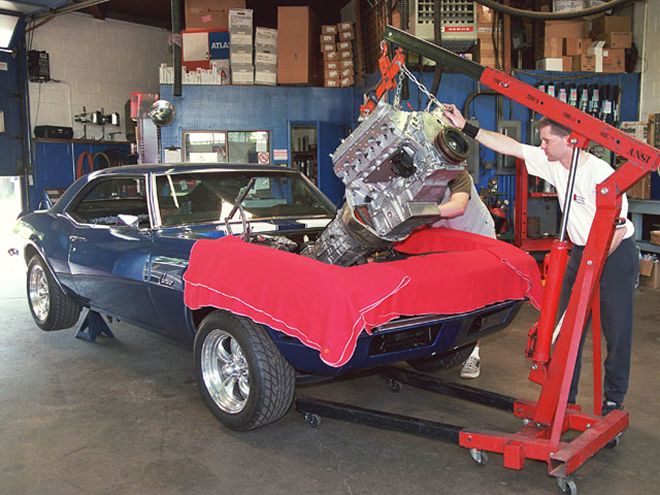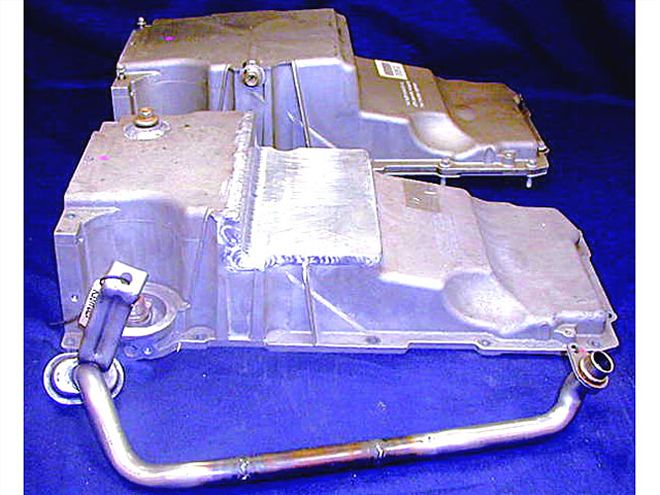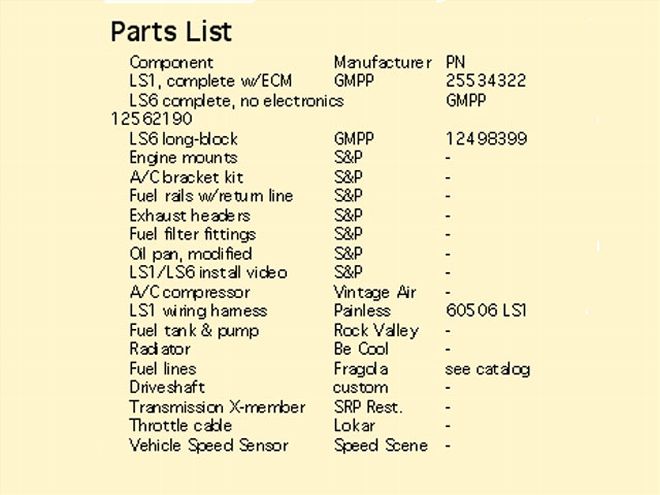

For many Bow Tie enthusiasts, there's only one Chevy musclecar--the first generation '67-'69 Camaro. With its timeless lines and racing heritage, the debut model is a classic in every sense of the word.
Of course, classic also means car crafters can't leave it alone, including swapping in more modern powerplants. Over the years, big-blocks, TPI, and LT1/LT4 small-blocks have all muscled their way between those familiar fenderwells. The latest effort involves using the covetous LS1 V-8.
One tuner firmly in the LS1 camp is Steve Heino, a Chevy-obsessed guy who blends business with pleasure at his shop, McGee's Auto Service in Lake Oswego, Oregon. In addition to repairing Toyotas and Tauruses, Heino is one of the Pacific Northwest's notable Chevrolet tuners, a claim backed up by a stable of satisfied customers and an always-busy DynoJet. Heino is particularly passionate about early Camaros, and he couldn't resist the temptation to swap an LS1 into his '68. What follows is a guide to LS1 Camaro engine swapping.
The LS1 debuted in the fifth-generation '97 Corvette, rated at a robust 345 hp and 350 lb-ft of torque. The next year GM spread the wealth, dropping LS1 engines into Camaro Z28s and Pontiac Firebirds in 305 and 320hp versions. Not to be outdone, the Corvette's standard LS1 jumped to 350 hp in 2001. Then came the new high-output, high-compression LS6 version that cranked out a neck-warping 385 ponies.
The LS1 incorporates a host of modern engine features unheard of when Chevrolet debuted the Camaro in 1966, including a composite tuned-length intake, sequential electronic fuel injection, and a distributorless ignition system with eight individual coils. Heck, even the LS1's firing order is different (1-8-7-2-6-5-4-3).
Like all modern engines, the LS1 is as reliant on computer code as it is on decomposed dinosaurs. All late-model GM fuel-injected engines are managed by a computer; in the LS1's case, it's the Powertrain Control Module (PCM). The LS1 PCM relies on programmable flash memory that governs spark timing and fuel delivery based on input from a litany of sensors that give feedback on various engine functions. Amazingly few sensors are really needed to run the engine in a non-emissions application. The following is an overview of what it takes to swap in an LS1.
Wiring Harness
After locating an engine, the first order of business is to figure out the wiring harness, the electrical lifeblood of the engine. For the brave of heart, modifying the stock LS1 Camaro or Corvette harness can be done, but it's a time-consuming, confusing job because much of the harness isn't required for a hot-rod application. Heino opted for an aftermarket LS1 harnesses from Painless Performance. The Painless LS1 harness comes with all the factory connectors, OE diagnostic capability, fuse-panel, and relays. In addition, the Painless harnesses is GM-color-coded, and includes complete instructions.
 One of the first things that you need to address is converting to a modified Camaro oil pan to clear the existing early Camaro crossmember. Street & Performance offers a modified Camaro oil pan on an exchange basis.
One of the first things that you need to address is converting to a modified Camaro oil pan to clear the existing early Camaro crossmember. Street & Performance offers a modified Camaro oil pan on an exchange basis.
Oil Pan and Accessory Brackets
There are significant differences with oil pan design and accessory placement (A/C compressor, alternator, and so on) that must be considered when deciding between a Corvette and F-body LS1. The Corvette oil pan will not work in an early Camaro, while the stock F-body LS1 oil pan must be modified to clear the early Camaro's crossmember. The easiest solution is to use a Street & Performance-modified '67-'69 Camaro oil pan, available on an exchange basis.
The accessory drive also presents difficulties. With a Corvette LS1, you can use stock power steering and alternator brackets--but not the A/C compressor bracketry. You can either fabricate your own or buy Street & Performance's. Heino made his own, which is not difficult if you take your time.
If you choose to use a Camaro/Firebird LS1, you'll need to round up Corvette LS1 power steering and alternator brackets, then fab that A/C compressor bracket. Again, Street & Performance offers aftermarket brackets and accessories to make this all work. Moreover, S&P may take trades of some components to soften the financial impact.
Exhaust Manifolds and Headers
Stock LS1 exhaust manifolds, off either a Corvette or Camaro/Firebird, work perfectly in the early Camaro bodies with no modifications. If you're looking for more power and that distinctive header sound, Street & Performance (among many others) offers headers that fit.
Throttle-Body
Camaro and Corvette LS1 throttle-bodies also differ. Corvette throttle position is controlled by a fly-by-wire system, which sends gas-pedal input to a computer and servo, which pens the throttle electronically. Camaros, on the other hand, use the pragmatic cable system. Which means, if you're using a Vette engine, you'll need a Camaro cable-driven throttle-body. Don't even think about adapting the Corvette design unless you work for GM.
EFI Fuel Rails
Corvettes, '99 and later, plus all Camaros LS1s, use a fuel delivery system that does not require a fuel tank return line. This system is very difficult to adapt in an engine-swap situation. Fortunately, earlier '97-'98 Corvettes employ the traditional feed-and-return-line fuel system. If you happen to have a non-return-line LS1, the fuel rails must be modified for a two-line system. Once again, Street & Performance can modify your existing fuel rails or provide you with the correct fuel rails.
Fuel Pump, Fuel Tank, and Plumbing
With any EFI swap, you need to decide whether to put the fuel pump inside the tank--like the OEM--or use an external pump. Heino recommends an internal pump: It's quieter, more efficient, provides better fuel pickup (assuming the proper baffles and fuel traps), and provides longer pump life since the gas cools the pump.
For his '68 Camaro, Heino dialed up Rock Valley Antique Auto Parts in Illinois. Rock Valley has been building street rod and musclecar fuel tanks for two decades now, and makes a beautiful stainless-steel early Camaro fuel tank with all the fittings, baffles, and mounting hardware for the LS1 fuel pump. Modifying an existing tank with late-Camaro hardware is an option, too, but not recommended except with a brand-new tank. Never cut or weld on a used gas tank, for all the obviously explosive reasons.
As for fuel-line plumbing, Heino wanted hoses that offer foolproof reliability and look racy. This meant braided stainless steel hose and Series 3000 race fittings from Fragola Performance Systems. Heino used the flexible Fragola braided stainless steel hose for both feed and return lines. Another approach would have been to use the car's original steel fuel line for the return and run a new 3/8-inch line for the feed/pressure line. This could be either braided hose or hard steel line (although working the hard line through the frame is a challenge).
Motor Mounts
LS1 motor mounts are unique. There are six bosses on each side of the block that can be used to attach custom-made mounts. In some instances, mounts for a conventional small-block can be installed on an LS1 block with adapter plates. This was Heino's approach. While Street & Performance offers complete mounts, Heino wanted to place his engine 1 inch farther back to improve weight distribution.
Transmissions and Trans Mounts
Heino's LS1 is a modified '00 Corvette engine mated to the aftermarket version of the Camaro T56 six-speed transmission. The aftermarket and OE version of the T56 are nearly identical, except that the OE model is set up for the correct LS1 Vehicle Speed Sensor (VSS) and the late-model electronic speedometer. Since first-gen Camaros run cable-driven mechanical speedometers, Heino figured it would be easier to adapt a VSS than to modify his speedometer. To get around the VSS problem, he turned to Speed Scene Wiring, which offers the correct speed sensor and cable connection to use an OEM T56.
The stock T56 also moves the shifter location 6-7 inches back from the original Camaro location. This requires opening a new hole in the trans tunnel, as well as repositioning the interior console farther back, which is easy. If your Camaro is equipped with the rare bench seat, this might be difficult. The aftermarket version of the T56 places the shifter between the stock T56 position and the original four-speed location.
Radiator and Cooling Fans
Oftentimes, modern engine swaps serve up complicated cooling-system problems. Not the LS1-Camaro transplant. A stock Be Cool replacement radiator for first-gen Camaros fits nicely, and the electric fan/shroud assembly from a C5 Corvette can be adapted to fit with very minor modifications. As for radiator hoses, you'll need to wander through your local auto parts store, bent coat-hanger-pattern in hand, to find what you need or make a custom-bent length of tubing with short rubber connections on each end.
The Brain: Power Control Module
Regardless of which LS1 you choose, you must use the PCM that is intended for your specific motor. No mixing and matching allowed here. Unlike earlier TPI/TBI computers, the LS1 PCM is housed in a weatherproof box, which allows it to be mounted in the engine compartment. Once you have the conversion complete, it would be wise to have the PCM's flash memory reprogrammed for your application, especially if you've changed the cam. Computer software re-programmers allow tuners to tweak nearly every aspect of engine management, from deleting unnecessary codes, such as vehicle antitheft, to fine-tuning fuel mixture for optimum performance. Two companies that offer this service are LS1 Edit and The Turbo Shop (TTS), with software that allows you to modify the stock fuel and spark calibration.
While it's impossible to cover every detail and nuance involved in an engine swap, the LS1-into-Camaro swap is like all such projects: It requires patience, planning, and a willingness to see it through. The accompanying photos and captions will demonstrate that any skilled car crafter can pull off this conversion. And why not? Combining Chevy's best-ever musclecar with its best modern powerplant is surely worth the effort.

Finding an LS1
Since the first LS1s appeared nearly seven years ago, plenty of wrecking-yard engines are available. The only problem is, they're a hot item. LS1s complete with accessories and computer can be had for between $5,000-$7,000 at local wrecking yards. The online auction giant eBay always has several LS1 bidding wars brewing at any one time, especially since this site has become a convenient marketing tool for salvage yards. A quick eBay search while putting this story to paper found six complete LS1 engine/trans combos up for auction.
GM Performance Parts also offers an LS1 engine kit (2553422). Based on the Camaro/Firebird production LS1 engine, the kit includes exhaust manifolds, an automatic transmission flexplate, a wiring harness, and a computer that will operate both the engine and an electronically controlled 4L60E automatic transmission. No matter where you find your LS1, it's wise to get a complete engine/transmission, or a "conversion" package. That way you'll have all the little, but essential, parts necessary to complete the swap, including the correct computer.
Special thanks to Rick Voegelin for LS1 technical background.